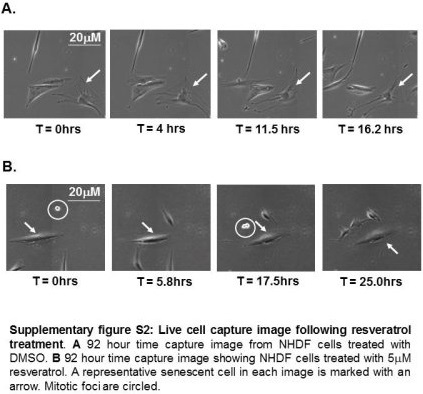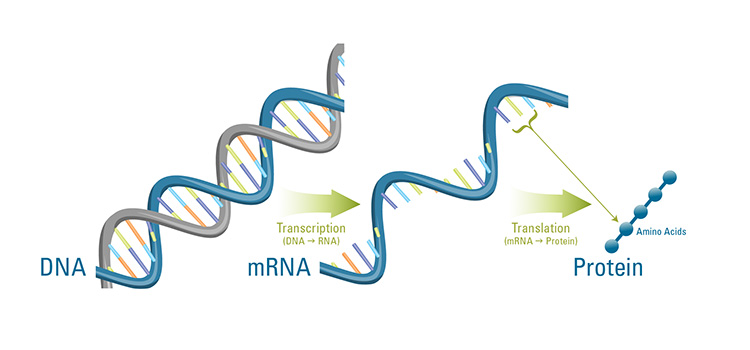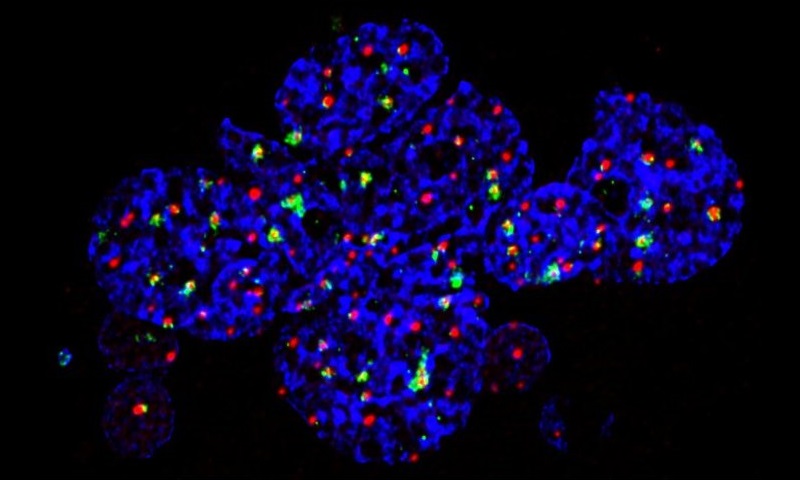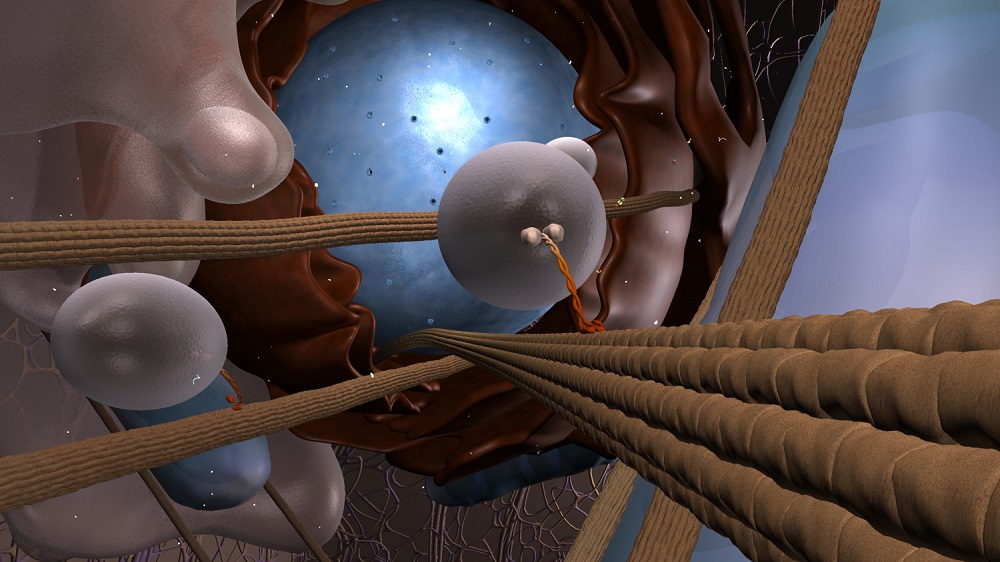Old Human Cells Rejuvenated with ‘Breakthrough’ Anti-Aging Discovery
Summary: Novel resveratrol analogs rejuvenate aging human cells, lengthening their telomeres and making them look and behave younger. [This article first appeared on LongevityFacts. Follow us on Reddit | Google+ | Facebook – Author: Brady Hartman.]
A team led by Professor Lorna Harries at the University of Exeter has discovered a new way to rejuvenate worn-out human cells called senescent cells. Within hours of treatment with the novel compound – a formulation of resveratrol – the older cells started to divide and had longer telomeres – the protective tips on the ends of chromosomes which shorten as we age.
The team of anti-aging researchers is based at the University of Exeter in the United Kingdom and includes Dr. Elizabeth Ostler and Professor Richard Faragher from the University of Brighton. The team published their findings in the journal, BMC Cell Biology.
The discovery builds on the research team’s earlier findings which showed that a class of cellular helpers called messenger RNA splicing factors become progressively switched off as we age. The team found that they could use chemicals to switch the splicing factors back on, which in turn made the senescent cells look and behave like younger cells and start dividing.
Announcing the finding in a press release, Professor Harries said:
“This is a first step in trying to make people live normal lifespans, but with health for their entire life. Our data suggests that using chemicals to switch back on the major class of genes that are switched off as we age might provide a means to restore function to old cells.”

The team of researchers rejuvenated the cells using novel resveratrol analogs. Resveratrol naturally occurs in red wine, blueberries, dark chocolate, and red grapes. The University of Exeter team discovered that the resveratrol analogs switched on the splicing factors in the aging cells. Within hours, the cells looked younger and began to rejuvenate and started dividing and acting like younger cells.
Senescent Cells Lose Messenger RNA
One of the hallmarks of aging is a build-up of damaged cells in our tissues called senescent cells. These non-functioning cells refuse to die and put the body into a state of low-level chronic inflammation called inflammaging, which in turn makes the body far more susceptible to conditions such as type 2 diabetes, aging skin, arthritis, and heart disease.
Senescent cells lose their ability to correctly regulate their genes, making us more susceptible to disease as we age. Notably, senescent cells experience a decline in splicing factors that aid the process of decoding our DNA and manufacturing proteins.

Our genes provide the instructions for building cells using messenger RNA (mRNA), a single-stranded RNA molecule that is complementary to one of the DNA strands in a gene. Splicing factors are essential in ensuring that our genes perform their full range of functions and help to build mRNA.
Messenger RNA is an RNA version of the gene that leaves the nucleus of the cell and moves to the cytoplasm where proteins are made. In general, one gene can be transcribed into a mRNA molecule that will end up making one specific protein. During protein synthesis by the translation machinery, a tiny worker called a ribosome moves along the mRNA, reads its base sequence, and uses the genetic code to build proteins.
Splicing Factors Decline With Age
As we grow older, our splicing factors tend to work less efficiently, or not all, degrading our cell’s capabilities to make mRNA. Geroscientists have linked mRNA processing as a key determinant of lifespan and have observed that as we age, levels of splicing factors decline in both our blood and certain cells. A decline in splicing factor levels causes cells to become dysfunctional. Most notably, senescent cells have fewer mRNA splicing factors, degrading their abilities.
Resveratrol Analogs
While resveratrol has a controversial history of extending lifespan, researchers have continued to test the original resveratrol compound as well as its variants, searching for the fountain of youth.
The authors of the University of Exeter study point out that resveratrol extends lifespan in various animals by activating the SIRT1 enzyme and increasing the levels of nicotinamide adenine dinucleotide (NAD). SIRT1 is a member of the family of seven sirtuin genes and plays a role in human longevity. Compared to resveratrol, there are far better ways to increase NAD, such as the compound nicotinamide mononucleotide (NMN). Moreover, a recent study shows that replenishing NAD with NMN rejuvenates mice.
Before conducting the experiment, the team led by Professor Harries designed a panel of novel resveratrol analogs to see which ones
“could restore splicing factor expression to levels comparable with those seen in young cells.”
The team identified and tested a total of six resveratrol analogs, including the original resveratrol compound, and documented the effects of the various compounds in their study. Because resveratrol is known to reduce markers of inflammation and inhibit a SIRT1, the geroscientists engineered each of these novel resveratrol analogs to have differing effects on SIRT1 and pro-inflammatory chemicals. The researchers verified that the resveratrol analogs reversed aging in the cells by restoring splicing function and ruled out other potential reasons for resveratrol’s rejuvenating effects, such as senescent cell clearance. The team reported that of the analogs, resveratrol had the most significant impact reducing the levels of inflammatory compounds and markers of inflammation, including IL-2, IL-6, IL-8, TNF-α, and IFNγ.
Bottom Line: Unlike senolytics which reduce chronic inflammation by killing senescent cells, the team found that resveratrol achieves the same effect by rejuvenating the splicing factors of senescent cells.
Resveratrol Analogs Rejuvenate Cells
The discovery could potentially lead to therapies which slow down the degeneration and disability that accompanies the aging process. As people get older, they are more prone to developing cancer, stroke, and heart disease and by the age of 85, most individuals have one or more chronic illnesses.
Dr. Eva Latorre, a Research Associate at the University of Exeter, participated in the experiments tested the resveratrol analogs on the cells. Dr. Latorre was surprised by the speed and extent of the changes in the cells, saying
“When I saw some of the cells in the culture dish rejuvenating I couldn’t believe it. These old cells were looking like young cells. It was like magic,” the researcher added, “I repeated the experiments several times and in each case the cells rejuvenated. I am very excited by the implications and potential for this research.”
Restoring Splicing Factors with Resveratrol Analogs
The University of Exeter team experimented with senescent cells and switched the splicing factors back on, using resveratrol analogs. The team was amazed to discover that many of the resveratrol analogs rejuvenated the aging cells and restored the length of their telomeres, a sign of rejuvenation. In announcing the finding, Professor Harries said:
“This demonstrates that when you treat old cells with molecules that restore the levels of the splicing factors, the cells regain some features of youth. They are able to grow, and their telomeres — the caps on the ends of the chromosomes that shorten as we age — are now longer, as they are in young cells. Far more research is needed now to establish the true potential for these sort of approaches to address the degenerative effects of ageing. “

What Causes Senescent Cells?
A variety of macromolecular damage can cause our cells to become senescent including toxins and radiation. The passage of time is another cause of senescence – our cells divide about 50 times, their telomeres shortening with each division. DNA damage is another cause of cellular senescence. When a cell becomes sufficiently damaged, it is programmed to self-destruct in a process called apoptosis, a form of cell death.
Unfortunately, some of these damaged cells refuse to commit suicide. The body’s immune system clears out many of these holdouts. However, our immune system weakens with age, causing increasing numbers of these senescent cells to build up. These walking dead can be found in most of our organs and tissues. Rather than functioning normally, senescent cells release massive amounts of inflammatory chemicals that significantly contribute to the chronic conditions of aging.
Other Ways to Deal with Senescent Cells
Researchers have found another way to deal with the trouble caused by senescent cells – by just killing them and eliminating them from the body. A group of drugs called senolytics clear senescent cells from the body and miraculously transform aging mice into seemingly younger ones. Geroscientists from around the world are racing to develop senolytics drugs and are testing them in humans as we speak. Recently, Mayo Clinic researcher Dr. James Kirkland, a leader in the field of anti-aging, published a review of age-reversing senolytic compounds and their potential for rejuvenation.
In dealing with the problem of senescent cells, senolytics appear to be superior to resveratrol analogs. One drawback of senolytics is that they kill senescent cells. Usually, these cells that can’t be replaced, leading to tissue atrophy. By restoring the vigor of senescent cells, resveratrol analogs hold promise that they can prevent the loss of vital tissue.
Resveratrol Analogs and Sirtuins
Resveratrol analogs have had a controversial history as potential life-extension drugs. The compounds were made famous by David Sinclair, a leading NAD advocate, who co-authored and published several papers on the rejuvenating effects of resveratrol analogs in leading scientific journals in the early 2000’s. Dr. Sinclair’s advocacy for resveratrol as an anti-aging compound started a scientific controversy, that has persisted to this day. Dr. Sinclair became famous for making bold statements about resveratrol such as:
“(It’s) as close to a miraculous molecule as you can find.” Adding, “One hundred years from now, people will maybe be taking these molecules on a daily basis to prevent heart disease, stroke, and cancer.”
Unfortunately, resveratrol has not been thoroughly tested in humans, because it cannot be patented. Moreover, ordinary resveratrol suffers from a lack of bioavailability. To overcome the patent limitations, a company called Sirtris formulated a resveratrol analog called SRT501. In 2008, GlaxoSmithKline (GSK) purchased Sirtris, however, seems to have abandoned efforts to develop resveratrol analogs and suspended a small clinical trial of SRT501 in 2010, due to safety concerns.
While limited human studies suggest that resveratrol is well-tolerated, one clinical study found that Alzheimer’s patients who take up to 2 grams of the supplement daily experience side effects, including diarrhea, nausea, and weight loss.
Another study of resveratrol showed that the compound boosted the health of mice fed a high-fat diet, however, did not increase the health of normal mice.
Bottom Line on Resveratrol Analogs
Ordinary resveratrol has poor bioavailability, and resveratrol analogs may overcome this limitation. Despite the controversy surrounding resveratrol analogs, many geroscientists still believe these compounds hold promise as lifespan-extenders. While there is plenty of data on resveratrol, unfortunately, there is a lack of clinical trials that test the effectiveness of resveratrol analogs in humans.
As we age, the levels of splicing factors in our bodies decline, contributing to dysfunction and disease. The University of Exeter study shows that resveratrol analogs boost the levels of splicing factors in cell cultures and restored telomere length. Both normal and accelerated aging causes shortened telomeres, in another study, on cells of children with progeria, Dr. Cooke showed that lengthening the telomeres of these cells rejuvenated them. While resveratrol holds promise as the fountain of youth, caution is warranted. More often than not, promising compounds have shown spectacular results in cell cultures only to be a flop in human trials, or even worse, harmful.
Related Articles
- Watch a short clip about gene editing in the ‘Future of Medicine’ (video).
- Learn about a man who is self-experimenting with gene therapy to rejuvenate his body.
- Discover how a novel Gene Therapy for Blindness May Soon Be Reality.
Show Us Some Love
- Help us spread the word – Show us some love and share this post on your social media account. It only takes one click on any of the social media links on this page.
- Follow us on social media – For more articles on healthy aging, follow us on Google+ or Reddit
- Sign up for our email list – We use your email to notify you of new articles. We don’t spam, and we won’t share your email address. Cancel at any time.
- Tell us what you think – We would love to hear from you. Scroll down and leave your comments below.
Resveratrol & Splicing Factor References
Cover photo: RNA at work. Courtesy of NCATS.
Splicing Factor References
Eva Latorre, Vishal C. Birar, Angela N. Sheerin, J. Charles C. Jeynes, Amy Hooper, Helen R. Dawe, David Melzer, Lynne S. Cox, Richard G. A. Faragher, Elizabeth L. Ostler, Lorna W. Harries. Small molecule modulation of splicing factor expression is associated with rescue from cellular senescence. BMC Cell Biology, 2017; 18 (1) DOI: 10.1186/s12860-017-0147-7.
University of Exeter. “Old human cells rejuvenated in breakthrough discovery on aging.” [Press Release] ScienceDaily, 7 November 2017. Link to press release.
Resveratrol References
Liu Y, Ma W, Zhang P, He S, Huang D; Ma; Zhang; He; Huang. “Effect of resveratrol on blood pressure: A meta-analysis of randomized controlled trials.” March 2014. Clinical Nutrition. 34 (1): 27–34. PMID 24731650. doi:10.1016/j.clnu.2014.03.009. Link to Article.
U.S. National Library of Medicine. Clinical trial number NCT00920556. “A Clinical Study to Assess the Safety and Activity of SRT501 Alone or in Combination With Bortezomib in Patients With Multiple Myeloma.”
Hausenblas HA, Schoulda JA, Smoliga JM, “Resveratrol treatment as an adjunct to pharmacological management in type 2 diabetes mellitus-systematic review and meta-analysis”. August 2014. Molecular nutrition & food research. 59 (1): 147–59. PMID 25138371. doi:10.1002/mnfr.201400173. Link to Article.
Turner RS, Thomas RG, Craft S, van Dyck CH, Mintzer J, Reynolds BA, Brewer JB, Rissman RA, Raman R, Aisen PS; Alzheimer’s Disease Cooperative Study “A randomized, double-blind, placebo-controlled trial of resveratrol for Alzheimer disease.” (2015). Neurology. 85 (16): 1383–91. PMC 4626244. PMID 26362286. doi:10.1212/WNL.0000000000002035. Link to Article.
Disclaimer
Diagnosis, Treatment, and Advice: This article is intended for educational and informational purposes only and is not a substitute for professional medical advice. The information and opinions provided herein should not be used during any medical emergency or for the diagnosis or treatment of any medical condition. SIRT501 and other resveratrol analogs are experimental compounds. Experimental drugs carry a much higher risk than FDA-approved ones. Consult a licensed and qualified physician for the diagnosis and treatment of any and all medical conditions. Call 911, or an equivalent emergency hotline number, for all medical emergencies. As well, consult a licensed physician before changing your diet, supplement or exercise programs. Photos, Endorsements, & External Links: This article is not intended to endorse organization, companies, or their products. Links to external websites, mention or depiction of company names or brands, are intended for illustration only and do not constitute endorsements.

5 Replies to “Old Human Cells Rejuvenated with ‘Breakthrough’ Anti-Aging Discovery”
Comments are closed.